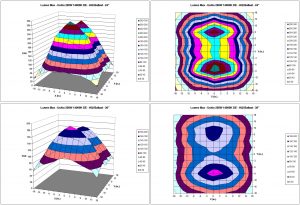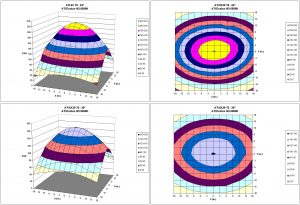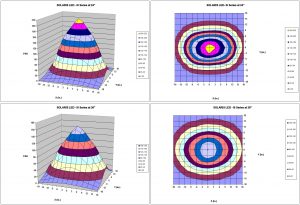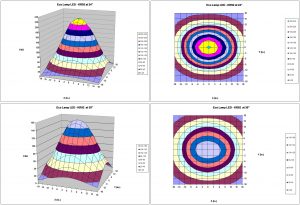Lighting technologies for reef aquarium have come a long way since I first started in the hobby about 20 years ago. Back then there were very few choices and 4300K to 5500K metal halide lamps and normal 40W fluorescent lamps were the standard choices. Since then there have been huge improvements in lighting technology and understanding of lighting applications for reef aquariums. Vast amounts of data on various metal halide lighting and ballasts have been collected and shared to show the differences between the various lamps and ballast combinations (www.manhattanreefs.com/lighting). European reef keepers have pushed the use of T5 lamps and shown that it is possible to keep exquisite reef tanks with intense colors of colors with these lamps. More recently LED lighting has advanced to the point where there are several LED lighting options available (or soon to be available) to the reef hobbyist. There are several examples of successful reef aquariums with PFO Solaris LEDs (one of the first ones to enter the reef market). It has become fairly obvious, that reef aquariums can be successfully maintained with any lighting technology as long as it is capable of providing enough quality light to sustain the coral inhabitants.
As a reef hobbyist one is often faced with the question of what should I use for my reef tank ? This question is not a simple one to answer as the needs, physical constraints, preferences, budgets may be different for different hobbyists coupled with the fact there is adequate evidence to show that all of these lighting options are potentially viable options for growing corals as long as one is willing to work within the limitations of each technology. However, the question of “How the different lighting technologies compare with respect to power input and light output and distribution?” can be more easily answered and backed quantitatively with data. The focus of this article is to show how the three different lighting technologies compare with respect to light output and distribution, and how the knowledge of this can be used to make more informed decisions.
Methodology
Examples of each of the different technologies were selected based on several criteria.
- The rated power should be roughly equivalent
- The light fixtures should be “state of the art” in their respective domains
This would allow for a “fair” comparison between the technologies, although the primary goal is to understand the differences in light output and distribution rather than declare a winner.
The combinations tested are listed in the table below:
| Technology | Lamp & Reflector | Picture |
|---|---|---|
| Metal Halide | 250W Double Ended Ushio 14K, Sunlight Supply LumenMax 3 | |
| T5 | EcoLux HO 6500K in36″ ATI Power Module (6X39W) | |
| LED | PFO Solaris – I5 Series | |
| Eco-Lamps KR92 | ||
| Pictures included here were taken from the respective websites of companies or their sellers. | ||
Data was collected using the same methodology as all my previous reflector tests, initially described in [ http://www.advancedaquarist.com/issues/mar2003/feature.htm ]. A 3’X 3′ grid with a spacing of 3″ in X and Y direction was created using a peg board. These 169 (13X13) points were used to collect data on this grid with (0,0) representing the center of the grid. A right hand coordinate system was used to designate the points on the grid, with the longitudinal axis of the reflector defining the X-axis or Y axis. Each reflector was approximately centered on this grid, so that the center of the reflector was aligned with the (0,0) position on the grid. For each of the above combinations listed in Table 1, data was collected at the 169 grid points and recorded, at a distance of 24″ and 30″ from the center of the light source. Data at each position was collected using a LICOR 1000 data logger and a LI-192SA underwater cosine corrected sensor calibrated for both air and water. Data on the photosynthetically available radiation (PAR) was collected as PPFD (Photosynthetic Photon Flux Density) measured in micromoles/m2/sec. The data logger was set to average 5 readings for each data collection point. Each set of complete readings for every reflector took approximately 3 hrs.
The data was imported into Microsoft Excel for analysis and the data was plotted in a manner that would be useful for evaluation. 4 plots of the data with 2 plots at each distance were generated:
- A 3-D surface plot showing the actual PAR values recorded
- A contour plot viewing the surface from the top showing the distribution
Test Data and Analysis
In the following sections, the results of the test data are presented. The data is presented in a form that can be easily interpreted by the reader, similar to all my past reflector tests and is quite self explanatory. Hence only some salient points for the options under consideration are discussed. When using the data to make comparison, there are several elements that must be taken into consideration especially since there are basic tradeoffs in any lighting system design – intensity vs. spread. Things to look for in the data are the basic shape of the light distribution, the amount of area coverage for a given level of light intensity, peak intensity values, and rate of change from the peak to the outer areas. When evaluating the reflectors for use on an aquarium, one needs to look at multiple performance criteria and select one that meets the needs of the tank, the tank layout, space constraints, and budget constraints.
Metal halide
A 250W double ended USHIO 14000K lamp in a Sunlight Supply Lumen Max 3 reflector driven by a “HQI” M80 ballast was used a representative of the class of metal halide lamps. Figure 1 below presents the light distribution for this combination. Peak values of PAR achieved were 278 micromoles/m2/sec at distance 24″ from the center of the lamp, and 190 at 30″ from the lamp center. Interestingly, the peak values are not directly below the center but offset from the center. The power consumption for this combination was 306 Watts.
Figure 1 shows the light output and distribution from the 250W Double Ended Ushio 14000K Lamp in Sunlight Supply Lumen Max 3 Reflector. The lamp in this case is aligned with the Y axis.
T5 Fluorescent
The 36″ATI Powermodule with 6 X 39W T5 lamps was claimed by many to be among the best in the class among the T5 fixtures and considered to be similar in power consumption to a 250W Metal halide setup. While there are a large number of combinations of T5 lamps that can be used, it would be a very time consuming and expensive task to acquire all such lamps and test them in this fixture. A representative lamp ATI EcoLux High Output 6500K lamp was chosen to perform the analysis for light distribution (primarily since I was able to acquire 6 of lamps easily). Figure 2 below shows the light distribution for this combination. Peak values of PAR achieved were 220 micromoles/m2/sec at distance 24″ from the center of the lamp, and 161 at 30″ from the lamp center. The power consumption as measured by a true RMS watt meter was 254 W.
LED – PFO Solaris I5
Just before PFO went out of business in 2009, they had developed the latest generation of LED fixtures, labeled the Solaris I5, and represented the best in class among the LED lighting options. While these are no longer in production, it is interesting to see how this technology compared to the others, especially given the skepticism of the consumers in the ability of LED to grow coral. The PFO Solaris LED fixture was a 24″ 2X30 LED array, with a mix of blue, white and a couple of green LEDs. Figure 3 below shows the light distribution for this combination. Peak values of PAR achieved were 213 micromoles/m2/sec at distance 24″ from the center of the lamp, and 160 at 30″ from the lamp center. The power consumption as measured by a true RMS watt meter was 216 W.
LED – Eco-Lamps KR92
In the last year LED technology has advanced quite significantly, making LED lighting an even more attractive option for reef keepers. A large number of these LED fixtures are being developed in the Asian countries. One such LED fixture is the Eco-Lamps KR92 fixture (http://www.eco-lamps.com/) . A 24″ version, with 91 LEDs was tested to evaluate the light distribution from some of the current generation of LEDs that are available in the market. Figure 4 below shows the light distribution for this combination. Peak values of PAR achieved were 224 micromoles/m2/sec at distance 24″ from the center of the lamp, and 160 at 30″ from the lamp center. The power consumption as measured by a true RMS watt meter was 110 W.
Discussion
Table 2 below summarizes some the parameters that are useful in evaluating the light output, power input, and peak light output. What is most interesting here is to note that other than the metal halide, the peak outputs of T5 and LED combinations used are roughly the same. The power consumption is significantly different (almost 50%) between the Eco-Lamps KR92 and Solaris I5 series, and ATI Powermodule. When faced with such data there is a tendency to jump to conclusions that a 250W metal halide is equivalent to one of these LED fixtures. However, just from the data in Table 2, we cannot conclude that these LEDs are equivalent to 250W metal halide lamps.
| Technology | Lamp & Reflector | Power Consumption | Peak ValuesAt 24″ | Peak ValuesAt 30″ |
|---|---|---|---|---|
| Metal Halide | 250W Double Ended Ushio 14K, Sunlight Supply LumenMax 3 | 306W | 278 | 190 |
| T5 | EcoLux HO 6500K in 36″ ATI Power Module (6X39W) | 254W | 220 | 161 |
| LED | 24″ PFO Solaris – I5 Series | 216W | 213 | 160 |
| Eco-Lamps KR92 | 110W | 224 | 160 |
Additional information to compare these setups is the light coverage provided by these setups. To evaluate the light coverage, we can define a cut off PAR value and look at the area that is covered by light that is equal to or exceeds this value. Based my experience with light measurements and 20+ years of keeping corals I have found that light levels of 100 PAR, at the bottom of tank is usually more than enough to allow keeping a wide range of corals successfully. Incidentally, my personal 500G (84″LX48″WX30″H) tank lit by 3 400W Ushio 14000K lamps in a Lumenarc reflector mounted about 12″ from the water surface has PAR readings at the bottom ranging from 80-120. With PAR levels averaging 100 at the bottom of the tank, there is enough of a light gradient to allow keeping high light loving corals in the top ½ to 2/3rd of the tank, with lower light corals scattered in the lower half. Most acropora and other light loving corals will thrive at light levels of 300-400. So using the criteria of area covered by light levels greater than or equal to 100, we can get a good idea of light spread and use that to determine tank dimensions for which these lights would be most suitable. Figure 5, shows the spread of light for these different lighting setups.
From this it should be quite clear that statements directly touting LEDs as being equal to 250W metal halides are correct as far a peak values of PAR are concerned. While the PAR values hit by 250W metal halides may be met, the area coverage must also be considered when making a valid comparison. The 250W setup as tested would be suitable for large tanks, roughly an area of 36″X30″ would be covered by one such fixture. The T5 light setup has a more elongate distribution as expected from a 36″ long light fixture, and covers an area roughly 36″X24″. The Solaris I5 would provide light values greater than 100, over an area of roughly 20″X16″, where as the KR-92 would cover an area of 24X18″ at 30″ above the aquarium. These comparisons were made using the “best in class” options available. If someone was using other reflectors and fixtures that were not as efficient as these then the areas covered by the MH and T5s would be even smaller with lower peak values. Some T5 lamps may have higher output than the ones used here, in that case the peaks reached by the T5 would be slightly higher with a slight increase in the area, that what is reported here.
Additionally, it should be noted that since the LEDs have virtually no heat input into the tank the LEDs can very easily be placed closer to the water. This would increase the peak light levels in the tank and also put more light directly into the tank, given the smaller spread of the light distribution. This makes more efficient use of the light as most of the generated light can be directed into the aquarium.
Conclusions
Based on this quantitative data, is its quite obvious that the LEDs have come of age in providing a viable solution to lighting reef aquaria. While a lot of other factors that may be involved in making decisions such as power savings, cost, longevity, controllability, cost of ownership etc. these are not the factors considered here. Based solely on quantitative light output data, I am excited about the future of this technology for reef aquarium use. In fact, I have replaced my lighting for the 29G reef aquarium with this Eco-Lamps KR-92 fixture, and am looking forward to replacing the 2X150W Metal Halides on my 55G reef with a 4ft version of this fixture. Future articles will present results on other LED fixtures that I am currently evaluating.












0 Comments